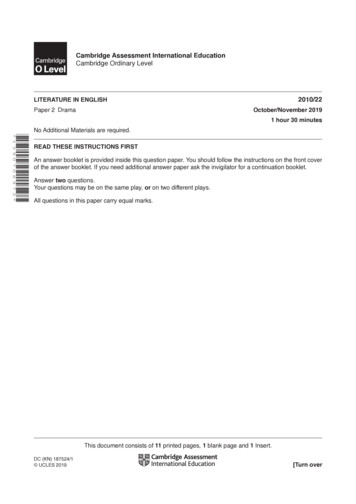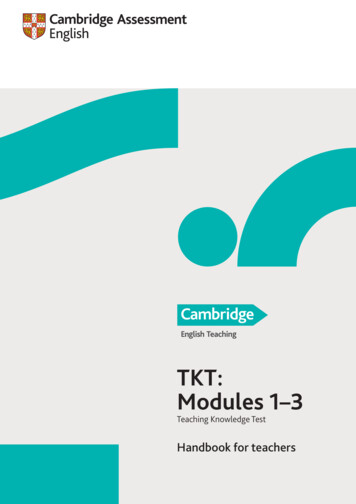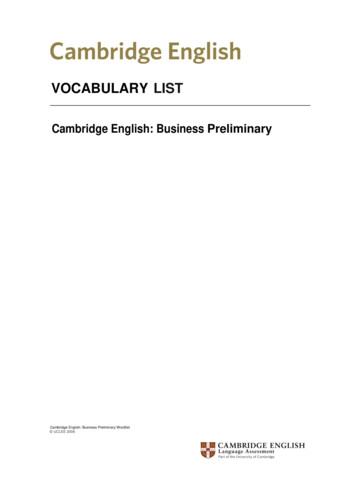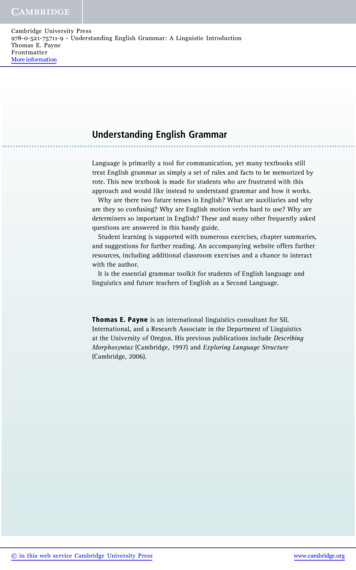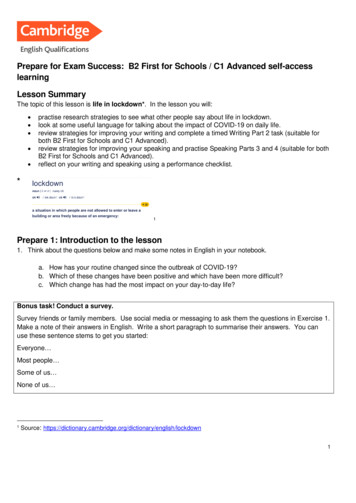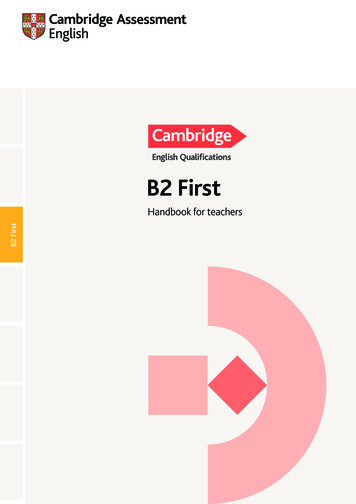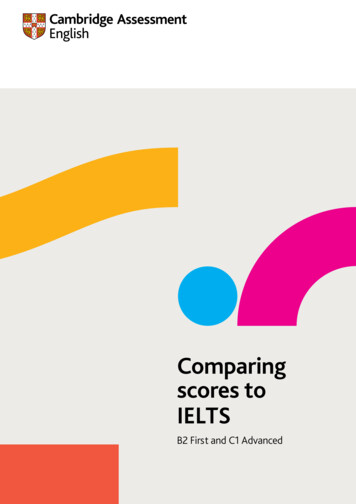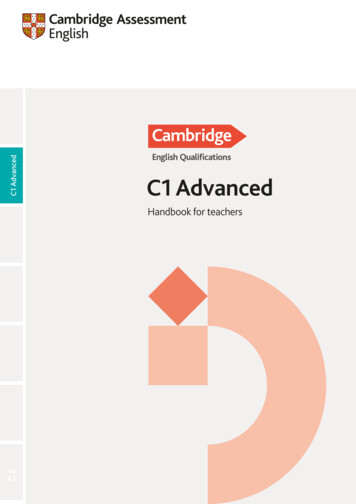
Transcription
C1 AdvancedC1 AdvancedHandbook for teachersPreA1
Your path tolearning English,step by stepcambridgeenglish.org/qualificationsC2 ProficiencyC1 AdvancedB2 FirstB1 PreliminaryA2 Key
Make the most of your handbookThe best way to get the most from your handbook is to use the digital version. The digital version isupdated more regularly.The digital version contains links which take you straight to related pages if you want to find out more. For example,you can read about Part 1 of the Reading and Use of English paper in the Tasks section, then click on the link to takeyou straight to a sample Part 1 task. There are also links which take you to useful websites and resources.TasksSample paper and assessmentThe Tasks pages give information about the exam format andwhat is tested in each part of the paper.The Sample paper and assessment section includes two samplepapers for each of the four components as well as answer keysfor the Reading and Use of English and Listening components. Forthe Writing and Speaking papers there is information about theassessment criteria, and for Writing there are example answers foryou to refer to or use with your learners.About Cambridge Assessment English 2C1 Advanced – an overview 3Exam support 4About the exam 5Paper 1: Reading and Use of EnglishPaper 3: ListeningTasksTasks55Sample paper and assessment59Sample paper and assessment712Paper 2: WritingPaper 4: SpeakingTasks29Tasks74Sample paper and assessment33Sample paper and assessment78Speaking assessment glossary of terms87Glossary90
About Cambridge Assessment EnglishWe are Cambridge Assessment English. Part of the University ofCambridge, we help millions of people learn English and provetheir skills to the world.For us, learning English is more than just exams and grades.It’s about having the confidence to communicate and access alifetime of enriching experiences and opportunities.We deliver qualifications and tests in over 130 countries to over5.5 million people every year.One of the top universities in the worldDepartments of the UniversityCambridge English Qualifications are in-depth exams that makelearning English enjoyable, effective and rewarding.Our unique approach encourages continuous progression with aclear path to improving language skills. Each of our qualificationsfocuses on a level of the Common European Framework ofReference (CEFR), enabling learners to develop and build speaking,writing, reading and listening skills.Our qualifications are based on research into effective teachingand learning. They motivate people of all ages and abilities tolearn English and develop practical skills for the real world.We have Cambridge English Qualifications for: Schools General and higher education BusinessThe largest assessment research capability of its kind in EuropeWhether learners are planning to live, work or study in their owncountry or abroad, our qualifications prove they have the Englishlanguage skills to succeed.To find out more about Cambridge English Qualifications and theCEFR, go to cambridgeenglish.org/cefrDepartments (exam boards)Cambridge Assessment EnglishWe help millions of people learnEnglish and prove their skills to theworld.Cambridge AssessmentInternational EducationPrepares school students for life, helpingthem develop an informed curiosity anda lasting passion for learning.OCR: Oxford Cambridge and RSAExaminationsOxford Cambridge and RSA2A leading UK awarding body.
C1 Advanced – an overviewC1 Advanced was originally introduced in 1991 and is a high-levelqualification that is officially recognised by universities, employersand governments around the world. It proves that a candidate hasa high level of English for use in academic or professional settings.CertificatesExam formats overall score on the Cambridge English ScaleC1 Advanced can be taken as either a paper-based or computerbased exam. level on the CEFRThe certificate shows the candidate’s: score on the Cambridge English Scale for each of the fourexam papers grade level on the UK National Qualifications Framework (NQF).Who is the exam for?C1 Advanced is aimed at learners who need to show they can: follow an academic course at university level communicate effectively at managerial and professional level participate with confidence in workplace meetings or academictutorials and seminarsThis is to certify that carry out complex and challenging researchName Surname stand out and differentiate themselves.has been awardedWho recognises the exam?in theThe C1 Advanced certificate is recognised around the world as ahigh-level qualification in English.Cambridge English Qualifications are accepted and trusted bythousands of organisations worldwide. For more informationabout recognition go to cambridgeenglish.org/recognitionWhat level is the exam?C1 Advanced is targeted at Level C1 on the CEFR.Achieving a certificate at this level proves that a candidate hasreached a very advanced level of English required in demandingacademic and professional settings.Statements of ResultsThe Statement of Results shows the candidate’s: Score on the Cambridge English Scale for their performance ineach of the four skills and Use of English. Score on the Cambridge English Scale for their overallperformance in the exam. This overall score is the averageof the separate scores given for each of the four skills andUse of English. Grade – this is based on the candidate’s overall score.Grade CCertificate in Advanced EnglishCambridge English Level 2 Certificate in ESOL International (Advanced)*Council of Europe LevelC1Overall score188ReadingUse of EnglishWritingListeningSpeaking169194186205188Date of ExaminationPlace of entryMay up (AM1) 2018CambridgeReference NumberAccreditation number185GB9618001500/2429/2*This level refers to the UK Regulated Qualifications ecutiveExecutiveChiefCambridge Assessment EnglishDate of issue: 02/05/19Certificate Number: 0000000000RegulationDP931CER 6360 V1 FEB19 Corporate Certificates Base Design Template SAP.indd 4031/03/2021 16:50Special circumstancesCambridge English Qualifications are designed to be fair to all testtakers. For more information about special circumstances, go tocambridgeenglish.org/help Level on the CEFR – this is also based on the overall score.C1 Advanced – an overview3
Exam supportOfficial Cambridge English preparation materialsFree support for candidatesTo support teachers and help learners prepare for their exams,Cambridge English and Cambridge University Press havedeveloped a range of official support materials includingcoursebooks and practice tests. These materials are availablein both print and digital formats.cambridgeenglish.org/exam-preparationWe provide learners with a wealth of exam resources andpreparation materials throughout our website, including examadvice, sample papers, candidate guides, games and onlinelearning port for teachersThe Teaching English section of our website provides user-friendly,free resources for all teachers preparing for our exams. It includes:Learners joining our lively Facebook community can get tips, takepart in quizzes and talk to other English language learners.facebook.com/CambridgeEnglishGeneral information – handbooks for teachers,sample papers.Registering candidates for an examDetailed exam information – format, timing, number ofquestions, task types, mark scheme of each paper.Exam entries must be made through an authorised CambridgeEnglish examination centre.Advice for teachers – developing students’ skills and preparingthem for the exam.Centre staff have all the latest information about our exams, andcan provide you with:Downloadable lessons – a lesson for every part ofevery paper. details of entry proceduresTeaching qualifications – a comprehensive range ofqualifications for new teachers and career development formore experienced teachers. exam datesSeminars and webinars – a wide range of exam-specificseminars and live and recorded webinars for both new andexperienced teachers.Teacher development – resources to support teachers in theirContinuing Professional acebook for teachersTeachers can join our community on Facebook for free resources,activities and tips to help prepare learners for Cambridge hTeaching4Facebook copies of the exam regulations current fees more information about C1 Advanced and other CambridgeEnglish Qualifications.We have more than 2,800 centres in over 130 countries – all arerequired to meet our high standards of exam administration,integrity, security and customer service. Find your nearest centreat cambridgeenglish.org/centresearchFurther informationIf your local authorised exam centre is unable to answer yourquestion, please contact our helpdesk:cambridgeenglish.org/help
About the examC1 Advanced is a rigorous and thorough test of English at Level C1.It covers all four language skills – reading, writing, listeningand speaking – and includes a fifth element focusing on thecandidate’s understanding of the structure of the language.Marks and resultsC1 Advanced gives detailed, meaningful results.Overall lengthA thorough test of all areas of language abilityThere are four papers: detailed information on each test paper isprovided later in this handbook, but the overall focus of each testis as follows:Number of Numbertasks/parts of itemsC1 AdvancedReadingand Useof English1 hour 30 mins856Writing1 hour 30 mins22Candidates have to show that they can produce two differentpieces of writing: a compulsory essay in Part 1, and one from achoice of three tasks in Part 2.Listeningapprox 40 mins430Listening: 40 minutes (approximately)Speaking15 mins4–Candidates need to show they can understand the meaningof a range of spoken material, including lectures, radiobroadcasts, speeches and talks.Totaltotal approx3 hours 55 minsReading and Use of English: 1 hour 30 minutesCandidates need to be able to understand texts frompublications such as fiction and non-fiction books, journals,newspapers and magazines.Writing: 1 hour 30 minutesSpeaking: 15 minutesCandidates take the Speaking test with another candidate orin a group of three, and are tested on their ability to take partin different types of interaction: with the examiner, with theother candidate and by themselves.Each of the four test components contributes to a profile whichdefines the candidates’ overall communicative language ability atthis level.All candidates receive a Statement of Results. Candidates whoseperformance ranges between CEFR Levels B2 and C2 (CambridgeEnglish Scale scores of 160–210) also receive a certificate.Grade A: Cambridge English Scale scores of 200–210Candidates sometimes show ability beyond Level C1. Ifa candidate achieves a Grade A in their exam, they willreceive the Certificate in Advanced English stating that theydemonstrated ability at Level C2.Grade B or C: Cambridge English Scale scores of 180–199If a candidate achieves Grade B or C in their exam, they will beawarded the Certificate in Advanced English at Level C1.CEFR Level B2: Cambridge English Scale scores of 160–179If a candidate’s performance is below Level C1, but falls withinLevel B2, they will receive a Cambridge English certificatestating that they demonstrated ability at Level B2.About the exam5
Can Do summaryWhat can candidates do at Level C1?The Association of Language Testers in Europe (ALTE) has researched what language learners can typically do at each CEFR level. Theyhave described each level of ability using Can Do statements, with examples taken from everyday life. Cambridge English, as one of thefounding members of ALTE, uses this framework to ensure its exams reflect real-life language skills.Typical abilitiesReading and WritingListening and SpeakingOverall general abilityCAN read quickly enough to cope with anacademic course, and CAN take reasonablyaccurate notes in meetings or write a piece ofwork which shows an ability to communicate.CAN contribute effectively to meetings andseminars within own area of work or keep upa casual conversation with a good degree offluency, coping with abstract expressions.CAN understand complex opinions/arguments asexpressed in serious newspapers.CAN pick up nuances of meaning/opinion.Social and touristWorkCAN write most letters they are likely to beasked to do; such errors as occur will not preventunderstanding of the message.CAN understand the general meaning ofmore complex articles without seriousmisunderstanding.CAN, given enough time, write a report thatcommunicates the desired message.Study6CAN scan texts for relevant information, andgrasp main topic of text.CAN keep up conversations of a casual nature foran extended period of time and discuss abstract/cultural topics with a good degree of fluency andrange of expression.CAN follow discussion and argument with onlyoccasional need for clarification, employinggood compensation strategies to overcomeinadequacies.CAN deal with unpredictable questions.CAN follow up questions by probing formore detail.CAN write a piece of work whose message can be CAN make critical remarks/express disagreementfollowed throughout.without causing offence.
Paper 1:1 hour 30 minsReading and Use of EnglishtasksThe paper contains eight parts. The Reading section consists of Parts 1, 5, 6, 7 and 8 of the paper. The Use of English section consists ofParts 2, 3 and 4.PartNumber ofquestionsNumber ofmarksTask typesFocusFormat188Multiplechoice clozeVocabulary, e.g. idioms,collocations, fixed phrases,complementation, phrasalverbs, semantic precision.A modified cloze containing eight gapsfollowed by eight 4-option multiplechoice items.2 88Open clozeAwareness and control ofgrammar with some focuson vocabulary.A modified cloze test containingeight gaps.Vocabulary, in particular theuse of affixation, internalchanges and compoundingin word formation.A text containing eight gaps. Each gapcorresponds to a word. The stems ofthe missing words are given beside thetext and must be changed to form themissing word.3 88Wordformation4 612Key wordGrammar, vocabulary,transformation collocation.5 66 4Six separate items, each with a lead-insentence and a gapped second sentenceto be completed in three to six words,one of which is a given ‘key’ word.12MultiplechoiceDetail, opinion, attitude,tone, purpose, main idea,implication, text organisationfeatures (exemplification,comparison, g of opinionand attitude; comparing andcontrasting of opinions andattitudes across texts.Four short texts, followed by multiplematching questions. Candidates mustread across texts to match a prompt toelements in the texts.A text followed by six 4-optionmultiple‑choice questions.12Gapped textCohesion, coherence, textstructure, global meaning.A text from which paragraphs havebeen removed and placed in jumbledorder after the text. Candidates mustdecide from where in the text theparagraphs have been removed.8 1010MultiplematchingDetail, opinion, attitude,specific information.A text or several short texts, precededby multiple-matching questions.Candidates must match a prompt toelements in the text.56787Total6Reading and Use of English Tasks7
The eight parts of the Reading and Use ofEnglish paperPART 1Multiple-choice clozeIn this part, there is an emphasis on vocabulary and grammar. Sample task and answer key: pages 12 and 19 Each correct answer in Part 1 receives 1 mark.Part 1 consists of a text in which there are eight gaps (plus one gapas an example). Each gap represents a missing word or phrase. Thetext is followed by eight sets of four words or phrases, each setcorresponding to a gap. Candidates have to choose which one ofthe four words or phrases in the set fills the gap correctly.Candidates are required to draw on their lexical knowledge andunderstanding of the text in order to fill the gaps. Some questionstest at a phrasal level, such as collocations and set phrases. Otherquestions test meaning at sentence level or beyond, with moreprocessing of the text required. A lexico-grammatical element maybe involved, such as when candidates have to choose the optionwhich fits correctly with a following preposition or verb form.PART 2 Open clozeIn this part, there is an emphasis on grammar and vocabulary. Sample task and answer key: pages 13 and 19 Each correct answer in Part 2 receives 1 mark.Part 2 consists of a text in which there are eight gaps (plus one gapas an example). Candidates are required to draw on their knowledgeof the structure of the language and understanding of the text inorder to fill the gaps. In this part, as there are no sets of words fromwhich to choose the answers, candidates have to think of a wordwhich will fill the gap correctly.The focus of the gapped words is either grammatical, such asarticles, auxiliaries, prepositions, pronouns, verb tenses and forms;or lexico-grammatical, such as phrasal verbs, linkers and wordswithin fixed phrases. The answer will always be a single word. Insome cases, there may be more than one possible answer and thisis allowed for in the mark scheme.The absence or misuse of punctuation is ignored, although spelling,as in all parts of the Use of English component, must be correct.PART 3 Word formationIn this part, there is an emphasis on vocabulary. Sample task and answer key: pages 13 and 19 Each correct answer in Part 3 receives 1 mark.Part 3 consists of a text containing eight gaps (plus one gap as anexample). At the end of some of the lines, and separated from thetext, there is a stem word in capital letters. Candidates need toform an appropriate word from given stem words to fill each gap.The focus of this task is primarily lexical, though an understandingof structure is also required. It tests the candidates’ knowledge ofhow prefixes, suffixes, internal changes and compounds are usedin forming words. Candidates may be required to demonstrateunderstanding of the text beyond sentence level.8PART 4 Key word transformationIn this part, there is an emphasis on grammar and vocabulary. Sample task and answer key: pages 14 and 19 Each correct answer in Part 4 receives 0, 1 or 2 marks.Part 4 consists of six questions (plus an example). Each questioncontains three parts: a lead-in sentence, a key word, and a secondsentence of which only the beginning and end are given. Candidateshave to fill the gap in the second sentence so that the completedsentence is similar in meaning to the lead-in sentence. The gapmust be filled with between three and six words, one of which mustbe the key word. They key word must not be changed in any way.In this part of the paper the focus is both lexical and grammaticaland a range of structures is tested. The ability to express amessage in a different way shows flexibility and resource in theuse of language.The mark scheme splits the answers into two parts andcandidates gain one mark for each part which is correct.PART 5 Multiple choiceIn this part, there is an emphasis on the understanding of a long text,including detail, opinion, tone, purpose, main idea, implication,attitude, and also text organisation features such as exemplification,comparison and reference. Sample task and answer key: pages 15 and 19 Each correct answer in Part 5 receives 2 marks.Part 5 consists of one long text, drawn from a variety of sourceswhich include fiction. The text is followed by six 4-optionmultiple-choice questions which are presented in the same orderas the information in the text so that candidates can follow thedevelopment of the text.This task tests detailed understanding, including opinions andattitudes expressed; the ability to distinguish between, for example,apparently similar viewpoints, outcomes or reasons. Candidatesshould be able to deduce meaning from context and interpret thetext for inference and style. They should also be able to understandtext organisation features such as exemplification, comparisonand reference, including lexical reference. The final question maydepend on interpretation of the text as a whole, e.g. the writer’spurpose, attitude or opinion.PART 6 Cross-text multiple matchingIn this part, there is an emphasis on identifying opinions andattitudes expressed across texts. Sample task and answer key: pages 16 and 19 Each correct answer in Part 6 receives 2 marks.Part 6 consists of four short texts, on a related theme, followedby multiple-matching prompts. In total, there are four questions.Candidates must read across texts to match a prompt to elementsin the texts. The prompts require candidates to read across thefour texts to understand the opinions and attitudes expressedin order to identify agreement and disagreement between thewriters. The items only provide information on the subject of theopinion, not the opinion itself: this is for the candidate to identify.Candidates may need to identify an opinion expressed in one ofthe texts and then identify which other text shares or contradicts
Paper 1this opinion, or they may need to identify which text differs fromthe other three in terms of an expressed opinion.PART 7 Gapped textIn this part, there is an emphasis on understanding how texts arestructured and the ability to follow text development. Sample task and answer key: pages 17 and 19 Each correct answer in Part 7 receives 2 marks.Part 7 consists of one long gapped text from which six paragraphsof equal length have been removed and placed in jumbled orderafter the text, together with a seventh paragraph which does notfit in any of the gaps. The text is usually from a non-fiction source(including journalism). This part tests comprehension of textstructure, cohesion, coherence and global meaning.Candidates are required to decide from where in the text eachparagraph has been removed. Each paragraph may be used onlyonce, and there is one paragraph that candidates do not need to use.Candidates need to read the gapped text first in order to gain anoverall idea of the structure and the meaning of the text, and tonotice carefully the information and ideas before and after each gapas well as throughout the whole of the gapped text. They shouldthen decide which paragraphs fit the gaps, remembering that eachletter may only be used once and that there is one paragraph whichthey will not need to use.PART 8 Multiple matchingIn this part, there is an emphasis on locating specific information,detail, opinion and attitude in a text or a group of short texts. Sample task and answer key: pages 18 and 19 Each correct answer in Part 8 receives 1 mark.Part 8 consists of one or two sets of questions followed by a singlepage of text: the text may be continuous, or divided into sections,or consist of a group of short texts. In total, there are 10 questionsand four to six options.Candidates are required to match the questions with the relevantinformation from the text. To do this, they need to understanddetail, attitude or opinion in the question, and locate a sectionof text where that idea is expressed, discounting ideas in othersections which may appear similar, but which do not reflect thewhole of the question accurately. Some of the options may becorrect for more than one question.In addition to the use of letters, e.g. A–F, the range of possibleanswers may be presented in the form of a list of, for example,names or people or places, titles of books or films or types ofoccupation.PreparationGeneral The texts in Parts 1, 2, 3, 5, 6, 7 and 8 all have titles. Encourageyour students to pay attention to each title as it will indicate themain theme of the text. Encourage your students to read through each text (Parts 1, 2 and3) carefully before beginning to answer the questions so that theyhave a clear idea of what it is about. In Parts 2 and 4, there may be more than one permissible answerfor a question. However, students should only give one answerReading and Use of English Tasksfor each question. If they give two answers, and one of them isincorrect, they will not be given a mark. If they want to change ananswer, they should rub it out. All parts of the paper have detailed instructions and the Use ofEnglish component also has completed examples. These shouldbe studied carefully so that your students know what kind ofanswers they are expected to give and how they should showthem on the answer sheet. Your students should be encouraged to read extensively so thatthey build up a wide vocabulary and become familiar with themany uses of different structures. This should enable them todeal with a range of lexical items and grammatical structures in avariety of text types. Your students should read as widely as possible both in class andat home. This will enable them to become familiar with a widerange of language. In class encourage your students to interactfully with each text by focusing on pre-reading questions. This willhelp train them in prediction techniques. It is helpful to introduce a programme of reading at home. Aspart of the weekly homework assignments, an idea might beto introduce a reading scheme which involves the studentsin providing verbal or written reviews on the texts they haveread. These could include: unabridged short stories or novels,newspaper and magazine articles, non-fiction, etc. Wherepossible, your students should be encouraged to follow up ontheir hobbies and interests by reading magazines or lookingon the internet for articles in English about sport, computers,fashion, etc. Research in these areas could also lead to a seriesof short class talks or articles for a class project. A class or schoolmagazine may also encourage interest in reading. It is important to make sure your students are familiar with theformat of the Reading component. It will be helpful to spendtime going through sample papers. The Reading component has astandard structure and format so that students will know what toexpect in each part of the paper. When studying for the paper, it will be useful for your students torefer to dictionaries and grammar books. However, they shouldalso develop strategies for operating independently of referencebooks (by, for example, guessing the meaning of unknown wordsfrom the context) as they are not permitted to take dictionariesinto the exam with them. They should be encouraged to read atext without thinking that they need to understand every word.Students often spend time worrying about the text at word levelrather than trying to get a more global view of what it is about.Focus your students’ attention on understanding the overallfunction and message of texts or sections of texts. Your students need to read the instructions, title and sub-title ofeach reading text carefully. This is meant to give them an idea ofwhat to expect from the text; it will tell them where the piecescome from and/or what the text is about. If there is a visual, itis usually included to help with a reference in the text that thestudents may not be familiar with, for example, a photo of acertain animal or place. Students should develop an efficient personal system forrecording the new vocabulary they learn. They should recordas much detail as possible, including information aboutcomplementation and collocations of the words learned. Encourage your students to plan their time carefully and not tospend too long on any one part of the test. They should try tomake sure that they have a few minutes at the end of the test tocheck through their answers. They can do the various parts of the9
test in any order, but it may be better to do them in the orderof the question paper so as to avoid the possibility of puttinganswers in the wrong sections of the answer sheet. It is important that your students are familiar with theinstructions on the front page of the question paper, and for eachpart of the test. Your students should also be familiar with thetechnique of indicating their answers on the separate answersheet so that they can do this quickly and accurately. Studentsneed to be shown how to do this and have practice doing this ina timed exercise. They must record their answers on the answersheet. When writing their answers on the answer sheet, theymust be careful to make sure that they put the answer by theappropriate question number. This is especially important if theyleave some questions unanswered. They must also be sure towrite in capital letters in Parts 2, 3 and 4. When your students are familiar with the different task types,it is a good idea to discuss which part(s) take them longer tocomplete. Following this discussion you can suggest possibletimings for each task. Your students need to be reminded thatParts 4, 5, 6 and 7 are allocated 2 marks per question, whileParts 1, 2, 3 and 8 are allocated 1 mark per question. Students atC1 Advanced level need to process large quantities of text in adefined time-scale and therefore need practice in planning theirtime carefully. Remind your students to check the spelling of their answers asincorrect spelling will lose them marks. Remind your students that handwriting should be clear so that itcan be read easily by the markers.By partPART 1 When studying vocabulary in preparation for the paper, yourstudents should pay attention to collocation, the different shadesof meaning within sets of similar words, and complementation(e.g. whether words are followed by a certain preposition, or by agerund or an infinitive, etc.). Advise your students to consider all the options carefullybefore deciding on an answer. Some of the options may be verytempting, but only one will be semantically and grammaticallycorrect in that particular context.PART 2 Any preparation task which promotes grammatical accuracy isuseful, especially those which focus on verb forms and the use ofauxiliary and modal verbs, pronouns, prepositions, conjunctions,modifiers and determiners. Remind your students that only o
English Scale scores of 160–210) also receive a certificate. Grade A: Cambridge English Scale scores of 200–210. Candidates sometimes show ability beyond Level C1. If a candidate achieves a Grade A in their exam, they will . receive the Certificate in Advanced English stating

